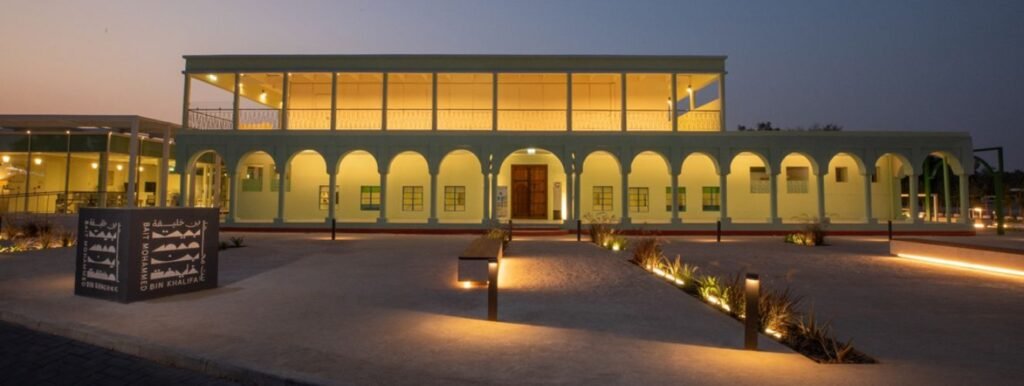Once a quiet and forgotten villa in Al Ain, Bait Mohammed bin Khalifa is now buzzing with energy, creativity, and community life. This heritage site, once the residence of the late Sheikh Mohammed bin Khalifa Al Nahyan, has been beautifully restored and reimagined as a dynamic cultural and creative space. It’s not just about preserving the past—it’s about bringing it into the present in a way that speaks to both locals and visitors.
In a country where development moves at the speed of light, it’s refreshing to see a project that holds onto the roots. Bait Mohammed bin Khalifa tells a story that goes beyond architecture. It’s a personal narrative, a symbol of leadership, and now, a platform for artistic voices to thrive.
A Home with Royal Legacy
Built in the 1950s, the house belonged to Sheikh Mohammed bin Khalifa, the father-in-law of the late Sheikh Zayed bin Sultan Al Nahyan, the Founding Father of the UAE. During the early days of the nation, this house wasn’t just a residence—it was a meeting point, a space where influential conversations took place, and a home that saw the early years of what would become the UAE’s modern history.

The building’s layout, with its inner courtyards and traditional construction materials, reflects the region’s climate-conscious architectural techniques. These walls have stood through the turning of decades, and even as the city around it transformed, the soul of the house remained intact.
From Heritage to a Hub of Creativity

Rather than letting the house fall into obscurity, the UAE’s cultural authorities took a different path. They saw in Bait Mohammed bin Khalifa not just a historical artifact but a living, breathing venue that could serve a new purpose.

Today, the house operates as a cultural centre, open to the public and offering everything from art exhibitions and workshops to community gatherings and storytelling sessions. Artists from across the region are invited to engage with the space, drawing inspiration from its unique character and history.
The rooms that once hosted family dinners and political talks are now filled with local crafts, digital installations, and creative expressions. The courtyard serves as a gathering spot, where events are held under the open sky, combining the charm of tradition with the energy of modern-day art.
What Makes It Special for Visitors
For those visiting Al Ain, Bait Mohammed bin Khalifa offers a different kind of tourist experience. It’s not about tall buildings or flashy attractions—it’s about slowing down and stepping into a piece of history. The way the restoration was handled means that visitors can still feel the soul of the home, while also engaging with new ideas and conversations that shape today’s cultural landscape.
There are guided tours that walk you through the story of the house, explaining its layout, its historical context, and the family that lived there. But the experience goes beyond just learning—it invites you to feel connected, to reflect, and to engage.
Workshops hosted here often include local artisans teaching visitors how to make traditional crafts, or musicians performing live compositions that blend old Emirati styles with contemporary sounds. It’s educational, but in the most engaging and hands-on way.
A Model of Heritage Revival in the UAE

The success of Bait Mohammed bin Khalifa is part of a larger movement happening across the Emirates—a revival of heritage sites that goes beyond restoration and focuses on reinvention. Instead of being static monuments, these places are being designed to live again, to adapt and to host new generations.
This approach fits beautifully with the UAE’s broader goals. As the country continues to grow as a hub of innovation and development, it’s making sure that its cultural identity isn’t left behind. In fact, it’s becoming stronger than ever.
Al Ain itself, known as the “Garden City” of the UAE, holds a special place in the nation’s history. The city is a UNESCO World Heritage Site, and the reopening of Bait Mohammed bin Khalifa only strengthens its importance as a cultural destination.
Empowering Local Talent and Community
One of the most heartwarming aspects of the Bait’s revival is how it empowers the local community. The centre provides a platform for Emirati artists, designers, musicians, and storytellers to showcase their talent. It’s also a meeting ground for residents to connect, learn, and collaborate.
Youth programmes are especially impactful, helping younger generations learn about their history in a way that’s interactive and inspiring. From photography classes to spoken word sessions, the house is now a launching pad for creative expression.
This mix of old and new—of legacy and innovation—is something the UAE is becoming increasingly good at. And Bait Mohammed bin Khalifa is a shining example of that success.
Looking Ahead
As Bait Mohammed bin Khalifa continues to evolve, its role in the cultural landscape of the UAE is only growing. It has shown that heritage doesn’t have to be frozen in time. With thoughtful restoration and meaningful programming, it can become a vessel for progress, reflection, and unity.
Visitors leave with more than just photos—they leave with stories, emotions, and a deeper appreciation of Emirati identity. In every restored wall and in every event held on its grounds, there’s a message: the past still matters, and it has a lot to teach the present.
So whether you’re a local wanting to reconnect with your roots, or a traveler looking for something real and enriching, Bait Mohammed bin Khalifa offers that rare blend of authenticity and inspiration. It’s not just a house—it’s a home for culture, and it’s full of life once again.
Also read: Desert Rose Tourism: Exploring the Heart of the UAE’s Natural Beauty














